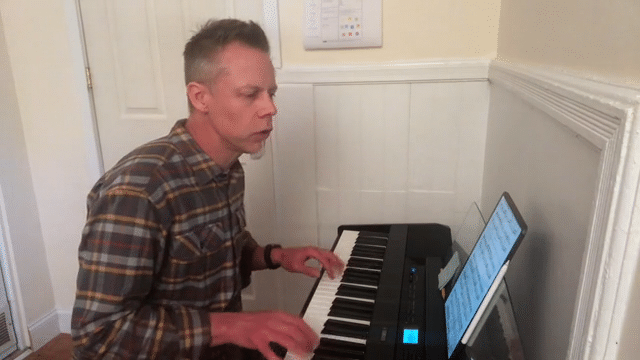Which is better, Open Space Technology or Lean Coffee?
We explored Open Space and Lean Coffee at QCon London 2014. We put 15 facilitated peer sharing sessions on the program. We thought we would hold a series of 15 short Open Spaces, each one focused on a different conference track, staggered throughout the day. The conference was three days long, with 5 tracks each day, for a total of 15 sessions.
We thought we would convene each of the peer sharing sessions as Open Space, like we did at QCon San Francisco 2013. We built an “Open Space In a Box”—everything you need to tear down, move, and set up Open Space in 15 minutes. With 20 minutes between sessions, we had our work cut out for us: we had to tear down, move to a different floor and room in the conference center, set up, and open space, five times a day. Our kit included these beautiful pre-printed poster boards displaying the Open Space agenda space-time matrix and the Open Space principles and law, pre-printed conversation space labels, pre-cut paper for session topics, a set of pens, and a singing bowl. Combined with a crew of amazing volunteers and conference center staff, we could tear down and set up in 15 minutes, just enough time for me to catch my breath and facilitate.
We also built a web site to make it easy for session conveners to add their session to the proceedings.
Attendance at each session varied, depending on time of day, competition with other programmed conference sessions being held at the same time, difficulty finding some of the meeting rooms in the conference center, and who knows what else. Numbers ranged from 8 to 40 people. With 40 people in the room, Open Space is perfect. There’s a lot of energy and excitement, a full agenda of topics, and the right number of people at each conversation. (“More than eight, no collaborate.”)
With only eight people in the room, Open Space didn’t feel right. Why go through the trouble of proposing sessions that there aren’t enough people to attend each session, connect with each other, and share and create new knowledge together? Yeah, I believe in the principle that Whoever comes is the right people, but for spreading knowledge at a conference, I want people to be energized and engaged, to leave the room happy with their experience, to come back for another session and to invite their friends to join them.
Here are some of my thoughts and observations on various dimensions of Open Space and Lean Coffee, having done each of them 7 or 8 times in three days.
|
Open Space
|
Lean Coffee
|
|
|
Canonical purpose
|
Solve a thorny problem together
|
Share knowledge
|
|
Materials needed
|
For fast set-up: Pre-printed posters for the space-time matrix and for the principles & law, …In general: Posters for the principles & law, paper, blue tape, pens, labels for conversation spaces, a chime
|
Hardly anything: Post-its and pens
|
|
Set up time
|
Fast set-up: 15 minutes if you have an Open Space-in-a-box kit, like we use at QConIn general: 1-2 hours
|
No time at all
|
|
Opening time
|
Minimum 10-15 minutes to open and start the first conversation
|
Same, maybe closer to 10 minutes
|
|
“Boarish” behavior
|
It’s hard to dominate a conversation because of the Law of Two Feet and multiple simultaneous conversations
|
There’s one conversation and people are reluctant to apply the Law of Two Feet, so it’s easier to dominate a conversation
|
|
Potential to feel slighted
|
Low—all topics are OK, this isn’t brainstorming, you might be the only one who shows up at your session and that’s OK
|
Higher—we vote on topics, and your topic might get 0 votes. It’s very visible that it’s your topic and that we’re not interested.
|
|
Quantity and quality of topics
|
Fewer, higher quality topics: there’s a game board (the space-time matrix), with a limited number of squares; people notice, and they act responsibly
|
More topics, potentially lower quality: there’s apparently no limit to the number of topics we can propose, so we propose everything that’s on our mind
|
|
# of conversations
|
More conversations, held simultaneously (high concurrency)
|
Fewer conversations (single threaded)
|
|
Facilitation work
|
Less work for facilitator: after opening space, stay out of the way
|
Heavier facilitation: dot-voting on topics, managing conversation time boxes, etc.
|
|
Facilitator as participant
|
Facilitator doesn’t participate in conversations
|
Facilitator can participate in conversations
|
|
Facilitator responsibility
|
Open Space well, and then it’s up to the participants to get a great result together
|
Great result depends on facilitator’s skills throughout the session
|
|
Transformation
|
Transforms people through the grief cycle together
|
Unrelated to the grief cycle
|
At the next QCon, we’ll continue exploring, looking for the best way to facilitate peer knowledge sharing. Maybe we’ll do Open Space, maybe we’ll do Lean Coffee, maybe we’ll try World Cafe, maybe we’ll try or invent something else. No matter what we try, it’s going to be great.
What are your experiences with Open Space Technology and Lean Coffee?





